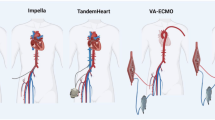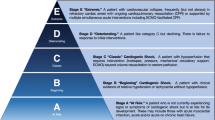Abstract
Purpose of Review
Percutaneous mechanical circulatory support devices (PMCSD) consist of the intra-aortic balloon pump (IABP), Impella (Abiomed Inc., Danvers, Massachusetts), Tandem Heart (Cardiac Assist, Inc., Pittsburgh, Pennsylvania), or extracorporeal membranous oxygenation (ECMO). They augment cardiac output, cardiac index, and cardiac power which allow the operator to mitigate hemodynamic perturbations during high-risk percutaneous coronary intervention (HR-PCI). This review discusses PMCSD and their contemporary literature.
Recent Findings
Recent literature has substantiated the hemodynamic benefits of PMCSD in HR-PCI and cardiogenic shock, but no mortality benefit was found.
Summary
As stent technology improves, PCI is expanding into high-risk cases in which PMCSD provide hemodynamic support allowing safe and complete revascularization.




Similar content being viewed by others
References
Papers of particular interest, published recently, have been highlighted as: • Of importance •• Of major importance
•• Rihal C, Naidu S, Givertz M, Szeto W, Burke J, Kapur N, et al. Scai/Acc/Hfsa/Sts clinical expert consensus statement on the use of percutaneous mechanical circulatory support devices in cardiovascular care: endorsed by the American Heart Assocation, the Cardiological Society of India, and Sociedad Latino Americana De Cardiologia Intervencion; affirmation of value by the Canadian Association Of Interventional Cardiology-Association Canadienne De Cardiologie D'intervention. J Am Coll Cardiol. 2015;65(19):E7–E26. This article provides an expert consensus statement on the use of percutaneous mechanical circulatory support devices. https://doi.org/10.1016/j.jacc.2015.03.036.
Myat A, Patel N, Tehrani S, Banning AP, Redwood SR, DL B. Percutaneous circulatory assist devices for high-risk coronary intervention. Jacc Cardiovasc Interv. 2015;8(2):229–44. https://doi.org/10.1016/j.jcin.2014.07.030.
American College Of Emergency P, Society For Cardiovascular A, Interventions, O’gara P, Kushner F, Ascheim D, Casey D Jr, Chung M, et al. Accf/Aha guideline for the management of St-elevation myocardial infarction: a report of the American College Of Cardiology Foundation/American Heart Association task force on practice guidelines. J Am Coll Cardiol. 2013;61:E78–140.
Mishra S. Upscaling cardiac assist devices in decompensated heart failure: choice of device and its timing. Indian Heart J. 2016;68(Suppl 1):S1–4. https://doi.org/10.1016/j.ihj.2015.12.012.
Cheng J, Den Uil C, Hoeks S, Van Der Ent M, Jewbali L, Van Domburg R, et al. Percutaneous left ventricular assist devices vs. intra-aortic balloon pump counterpulsation for treatment of cardiogenic shock: a meta-analysis of controlled trials. Eur Heart J. 2009;30(17):2102–8. https://doi.org/10.1093/eurheartj/ehp292.
Jones H, Kalisetti D, Gaba M, Mccormick D, Goldberg S. Left ventricular assist for high-risk percutaneous coronary intervention. J Invasive Cardiol. 2012;24(10):544–50.
Meraj P, Doshi R, Schreiber T, Maini B, O'neill W. Impella 2.5 initiated prior to unprotected left main Pci in acute myocardial infarction complicated by cardiogenic shock improves early survival. J Interv Cardiol. 2017;30(3):256–63. https://doi.org/10.1111/joic.12377.
Goldstein J, Kern M. Percutaneous mechanical support for the failing right heart. Cardiol Clin. 2012;30(2):303–10. https://doi.org/10.1016/j.ccl.2012.03.007.
Anderson M, Goldstein J, Milano C, Morris L, Kormos R, Bhama J, et al. Benefits of a novel percutaneous ventricular assist device for right heart failure: the prospective recover right study of the Impella Rp device. J Heart Lung Transplant. 2015;34(12):1549–60. https://doi.org/10.1016/j.healun.2015.08.018.
Cheung A, White C, Davis M, Freed D. Short-term mechanical circulatory support for recovery from acute right ventricular failure: clinical outcomes. J Heart Lung Transplant. 2014;33(8):794–9. https://doi.org/10.1016/j.healun.2014.02.028.
Tomasello S, Boukhris M, Ganyukov V, Galassi A, Shukevich D, Haes B, et al. Outcome of extracorporeal membrane oxygenation support for complex high-risk elective percutaneous coronary interventions: a single-center experience. Heart Lung. 2015;44(4):309–13. https://doi.org/10.1016/j.hrtlng.2015.03.005.
Perera D, Stables R, Thomas M, Booth J, Pitt M, Blackman D, et al. Elective intra-aortic balloon counterpulsation during high-risk percutaneous coronary intervention: a randomized controlled trial. JAMA. 2010;304(8):867–74. https://doi.org/10.1001/jama.2010.1190.
Perera D, Stables R, Clayton T, De Silva K, Lumley M, Clack L, et al. Long-term mortality data from the balloon pump-assisted coronary intervention study (Bcis-1): a randomized, controlled trial of elective balloon counterpulsation during high-risk percutaneous coronary intervention. Circulation. 2013;127(2):207–12. https://doi.org/10.1161/CIRCULATIONAHA.112.132209.
Thiele H, Zeymer U, Neumann F, Ferenc M, Olbrich H, Hausleiter J, et al. Intra-aortic balloon counterpulsation in acute myocardial infarction complicated by cardiogenic shock (Iabp-shock ii): final 12 month results of a randomised, open-label trial. Lancet. 2013;382(9905):1638–45. https://doi.org/10.1016/S0140-6736(13)61783-3.
O'neill W, Kleiman N, Moses J, Henriques J, Dixon S, Massaro J, et al. A prospective, randomized clinical trial of hemodynamic support with Impella 2.5 versus intra-aortic balloon pump in patients undergoing high-risk percutaneous coronary intervention: the Protect ii study. Circulation. 2012;126(14):1717–27. https://doi.org/10.1161/CIRCULATIONAHA.112.098194.
Kovacic J, Kini A, Banerjee S, Dangas G, Massaro J, Mehran R, et al. Patients with 3-vessel coronary artery disease and impaired ventricular function undergoing Pci with Impella 2.5 hemodynamic support have improved 90-day outcomes compared to intra-aortic balloon pump: a sub-study of the protect Ii trial. J Interv Cardiol. 2015;28(1):32–40. https://doi.org/10.1111/joic.12166.
Seyfarth M, Sibbing D, Bauer I, Frohlich G, Bott-Flugel L, Byrne R, et al. A randomized clinical trial to evaluate the safety and efficacy of a percutaneous left ventricular assist device versus intra-aortic balloon pumping for treatment of cardiogenic shock caused by myocardial infarction. J Am Coll Cardiol. 2008;52(19):1584–8. https://doi.org/10.1016/j.jacc.2008.05.065.
• Ouweneel D, Eriksen E, Sjauw K, Van Dongen I, Hirsch A, Packer E, et al. Percutaneous mechanical circulatory support versus intra-aortic balloon pump in cardiogenic shock after acute myocardial infarction. J Am Coll Cardiol. 2017;69(3):278–287. This study provides contemporary evidence for the use of Impella Vs. Iabp In cardiogenic shock after an acute myocardial infarction. https://doi.org/10.1016/j.jacc.2016.10.022.
Thiele H, Sick P, Boudriot E, Diederich K, Hambrecht R, Niebauer J, et al. Randomized comparison of intra-aortic balloon support with a percutaneous left ventricular assist device in patients with revascularized acute myocardial infarction complicated by cardiogenic shock. Eur Heart J. 2005;26(13):1276–83. https://doi.org/10.1093/eurheartj/ehi161.
Dixon S, Henriques J, Mauri L, Sjauw K, Civitello A, Kar B, et al. A prospective feasibility trial investigating the use of the Impella 2.5 system in patients undergoing high-risk percutaneous coronary intervention (the Protect I trial): initial U.S. experience. Jacc Cardiovasc Interv. 2009;2(2):91–6. https://doi.org/10.1016/j.jcin.2008.11.005.
Guenther S, Theiss H, Fischer M, Sattler S, Peterss S, Born F, et al. Percutaneous extracorporeal life support for patients in therapy refractory cardiogenic shock: initial results of an interdisciplinary team. Interact Cardiovasc Thorac Surg. 2014;18(3):283–91. https://doi.org/10.1093/icvts/ivt505.
Lee J, Park J, Kang J, Jeon K, Jung J, Lee S, et al. The efficacy and safety of mechanical hemodynamic support in patients undergoing high-risk percutaneous coronary intervention with or without cardiogenic shock: Bayesian approach network meta-analysis of 13 randomized controlled trials. Int J Cardiol. 2015;184:36–46. https://doi.org/10.1016/j.ijcard.2015.01.081.
Author information
Authors and Affiliations
Corresponding author
Ethics declarations
Conflict of Interest
Subrata Kar declares that he has no conflict of interest.
Human and Animal Rights and Informed Consent
This article does not contain any studies with human or animal subjects performed by any of the authors.
Additional information
This article is part of the Topical Collection on Ischemic Heart Disease
Rights and permissions
About this article
Cite this article
Kar, S. Percutaneous Mechanical Circulatory Support Devices for High-Risk Percutaneous Coronary Intervention. Curr Cardiol Rep 20, 2 (2018). https://doi.org/10.1007/s11886-018-0946-2
Published:
DOI: https://doi.org/10.1007/s11886-018-0946-2




